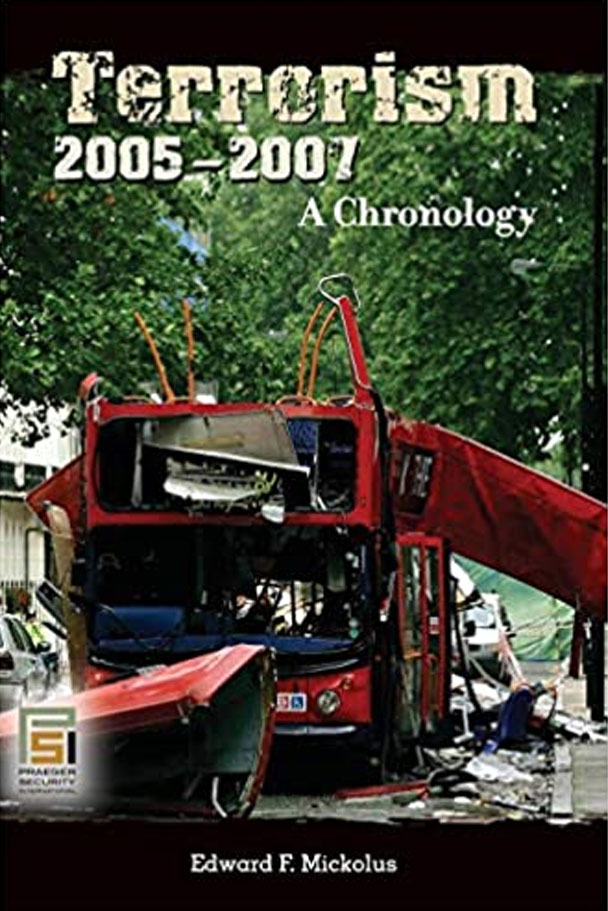Following previous trends of suicide bombings and violence against Western and local hostages, the 2005-2007 period saw a continuing tide of terrorism. Mickolus catalogues these recent insurgencies and technique, including airplane hijackings, letter bombs, food tampering, and major assassinations.
An extension of his other other works, including terrorism dating back to 1980, this comprehensive chronology also provides follow-up material to prior incidents and enumerates their effects on current airport security measures around the world. This volume expertly details key players in each event, ranging from the terrorist whose violence created an atmosphere of fear and anxiety, to their unknowing victims.
This work is divided into three sections: incidents, updates, and bibliography. In the first two segments, both domestic and international terrorist attacks are examined within security and political contexts to shed light on how the events unfolded. The extensive bibliographic data is also an invaluable resource for scholars, international organizations, and students.
- Title : Terrorism, 2005-2007: A Chronology
- Authors : Edward Mickolus
- Publisher : Praeger Security International
- Publication Date : September 30, 2008
- Language : English
- Hardcover : 296 pages
- ISBN-10 : 0313334951
- ISBN-13 : 978-0313334955
- Item Weight : 1.41 pounds
- Dimensions : 7 x 0.69 x 10 inches

Review
“In this exhaustive, two-year catalog of international terrorist actions, Mickolus (co-author, Terrorism, 2002-2004) organizes events by year, month, and day…. Researchers will find the 22-page, thematically organized bibliography extremely practical. Recommended for world history and peace-and-conflict studies collections.”―Library Journal
“… this series remains the most comprehensive chronology and bibliography on international terrorism. This new supplement is recommended for academic collections.”―Lawrence Looks at Books
“This is a useful introduction to researchers desirous of having a period chronological listing of international terrorism incidents.”―ARBA
“…The result is a relatively comprehensive chronological catalogue of terrorist acts. . . . For a quick assessment of domestic and international terrorist acts during this period, from which students and analysts can ascertain patterns of events and perpetrators, the Mickolus chronology is the place to start.”―The Intelligence Officer’s Bookshelf, CIA
Introduction
With the publication of this volume, I have been writing this series of chronologies for more than three decades. Although I have hoped that each volume will be the last—because terrorism would expire—or slimmer—because terrorism would decrease—experience now suggests that I should not predict this to be the last in the series.
Using a comprehensive definition, these books consider terrorism to be the use or threat of use of violence by any individual or group for political purposes. The perpetrators may be functioning for or in opposition to established governmental authority. A key component of international terrorism is that its ramifications transcend national boundaries, and, in so doing, create an extended atmosphere of fear and anxiety. The effects of terrorism reach national and worldwide cultures as well as the lives of the people directly hurt by the terrorist acts. Violence becomes terrorism when the intention is to influence the attitudes and behavior of a target group beyond the immediate victims. Violence becomes terrorism when its location, the victims, or the mechanics of its resolution result in consequences and implications beyond the act or threat itself.
The period of 2005-2007 saw the continuation of trends identified in previous years, although it also saw the failure of some long-held analytic predictions. Loosely knit bands of individuals, often linked to one particular religious zealot, continued to be viewed as the chief threat around the world. It was particularly evident in attacks in Iraq, which has served as the focal point for various Islamists. The number of attacks against coalition forces in Iraq far outnumbers those committed throughout the rest of the world—so much so that the numbers used herein diverge radically from the official figures issued by the US Government that include Iraq attacks, which often are in the dozens for a day.
The Iraqi terrorists—call them insurgents, civil warriors, Islamists, or what you will—have also shown a level of sustained viciousness not seen in other campaigns, with the possible exception of Algeria in the 1950s and 1990s. Several suicide bombings in heavily populated urban areas have become commonplace daily events for Baghdadis, and beheadings of Western and local hostages have become often-clicked highlights on the web pages of terrorist sympathizers.
Tied to this phenomenon of posting videos of beheadings is the unpredicted behavior of terrorists regarding the Internet. Despite it being a tempting target, and with a host of hackers ready to attack this example of globalization and Western interdependence, terrorists have not, as of this writing, attempted to exploit security vulnerabilities in the web to cause massive disruptions. Rather, they have used it as part of their propaganda outreach to like-minded observers. Despite the efforts of security services to patch holes and take down terrorist websites, thousands have sprung up during the period covered by this book.
Attacks conducted, or even rumored, during this period have also dramatically affected everyday life for many, particularly travelers. The whiff of a possible terrorist use of binary explosives carried onto airplanes in unmixed form has led to even longer security queues at airports, draconian limitations on carryons, and a cottage industry in toiletries and water bottles at the exits of airports.
The current volume follows that same format and method as the previous ones. As in earlier volumes, the international terrorist incidents and airline hijackings are identified by an eight-digit code. The first six digits identify the date on which the incident became known as a terrorist attack to someone other than the terrorists themselves (e.g., the date the letter bomb finally arrived at the recipient’s office, even though terrorists had mailed it weeks earlier; or the date on which investigators determined that an anomalous situation was terrorist in nature). The final two digits ratchet the number of attacks that took place on that date. In instances in which either the day of the month or the month itself is unknown, “99” is used in that field.
The book is divided into three sections: Incidents, Updates, and Bibliography. The Incidents section provides a chronology and description of international terrorist activity for a given time period, based solely on publicly available sources. This series of chronologies is not intended to be analytical, but rather comprehensive in scope. As such, the Incidents section also includes descriptions of non-international attacks that provide the security and political context in which international attacks take place. In some cases, the international terrorists mimic the tactics of their non-international brethren. Often, these are the same terrorists working on their home soil against domestic, rather than foreign, targets. Domestic attacks often serve as proving grounds for techniques later adopted for international use. I have therefore included material on major technological, philosophical, or security advances, such as: the use of letter bombs; food tampering; major assassinations; attempts to develop, acquire, smuggled, or use precursors for an actual chemical, biological, radiological, or nuclear weapon; key domestic and international legislation and new security procedures; key arrests and trials of major figures; and incidents involving mass casualties. Non-international entries do not receive an eight-digit code.
The Updates section provides follow-up material to incidents first reported prior to January 1, 2005. For example, updates include information about the outcome of trials for terrorist acts occurring prior to 2005 and “where are they now” information about terrorists and their victims. The update is identified by the original incident date, and I have included enough prefatory material to give some context and to identify the original incident in the earlier volumes.
The information cutoff date for this volume is December 31, 2007.
The Bibliography section includes references drawn from the same public sources that provide the incidents, literature searches, and contributions sent by readers of previous volumes. It does not purport to be comprehensive. The citations are grouped into topic areas that were chosen to make the bibliography more accessible, and includes print and web-based material. The Bibliography gives citations on key events and may be referenced for more detail on specific attacks described in the Incidents section.
For those who prefer to run textual searches for specific groups, individuals, or incidents, a computer version of the 1960-2007 chronology is available from Vinyard Software, Inc., 2305 Sandburg Street, Dunn Loring, Virginia, 22027-1124, or e-mail via [email protected] The data set comes in a WordPerfect and Word textual version and looks remarkably like the volumes in this series of hardcopy chronologies. A numeric version offers circa 150 numeric variables describing the international attacks. The data sets can be purchased by specific year of interest.
Vinyard also plans to release the Data on Terrorist Suspects (DOTS) project in 2009 in conjunction with Greenwood’s release of my Directory of International Terrorists, 1950-2008: Leaders, Perpetrators, Financiers, Defendants, Detainees, Persons of Interest, Conspirators, and Others. It will offer a detailed biographical index of every terrorist suspect named in the previous volumes of this chronology.
Comments about this volume’s utility and suggestions for improvements for its likely successors are welcome and can be sent to me via [email protected]. Please send your terrorism publication citations to me at Vinyard to ensure inclusion in the next edition of the bibliography.
Once again, there are many individuals who have contributed to this research effort. Of particular note are Susan Simmons, who once again edited this volume and incorporated additional material in the Bibliography section, and my family, who once again endured nights and weekends of clacking computer keys.







